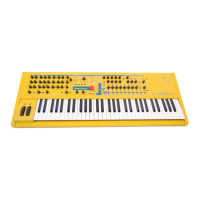Sound Parameters – Modulation Matrix
131 Waldorf Q User’s Manual
Modulation Matrix
A modulation can be described as influencing a sound parameter by a signal-generating unit. The
terms used in this context are "source" and "destination". The Q offers 16 independent modulation
assignments (slots) each with individual settings of source, destination and amount. The Modulation
Matrix is the key of the power of each Waldorf synthesizer, so start experimenting with it right now.
Basically, the Modulation Matrix is split in two kinds:
Fast Modulation Matrix (M1F…M8F)
These slots feature a high internal update rate, intended to be used for modulations that require to be
calculated very fast.
Standard Modulation Matrix (M1S…M8S)
These slots are calculated at normal speed, that is still fast enough for the most modulation purposes,
e.g. when dealing with the modulation wheel or velocity. The Standard Modulation Matrix slots offer
an extended set of modulation sources and destinations compared to the Fast Modulation Matrix.
For deep information about the modulation speed and tables of the various available sources
and destinations, read the chapter “Modulation Speed Levels” on page 57.
Matrix Edit Menu
All parameters related to the Modulation Matrix are located in the Matrix Edit Menu. Press the Master
section’s Matrix button and select the respective pages M1F…M8F or M1S…M8S with the Page Dial.
Source see Tables “Fast Modulation Sources” and “Standard Modulation Sources”
Defines the modulation source.
Amount -64…+63
Determines the amount of modulation applied to the destination. Since the modulation is in fact a
multiplication of the source signal and this parameter, the resulting amplitude depends on the type of
modulation source you select:
• For the so-called unipolar modulation sources, the resulting amplitude lies within the
range of 0…+1, if Amount is positive or 0…-1, if Amount is negative. These sources are:
all envelopes, all MIDI controllers including Modwheel, Foot control etc., Velocity,
Release Velocity, Aftertouch (Pressure) and Polyphonic Pressure.
• For the so-called bipolar modulation sources, the resulting amplitude lies within the range
of -1…0…+1. These sources are: all LFO, Keytrack, Pitchbend and the Modifiers.
Destination see Tables “Fast Modulation Matrix Destinations” and
“Standard Modulation Matrix Destinations”
Defines the modulation destination.

